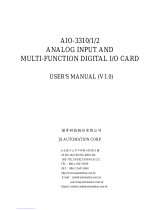
Contents
CONTENTS
CONTENTS .........................................................................................................................3
ABOUT THE MANUAL .......................................................................................................5
ABBREVIATIONS AND DEFINITIONS......................................................................................................... 5
NUMERICAL REPRESENTATION ............................................................................................................... 5
DOCUMENTS................................................................................................................................................ 5
1 INTRODUCTION TO THE SERIAL COMMUNICATION..............................................6
2 INTRODUCTION TO THE N2 COMMUNICATION ......................................................7
2.1 N2 MS/TP MESSAGES STRUCTURE .............................................................................................. 7
2.2 COMMANDS AND SUBCOMMANDS .............................................................................................. 7
2.3 POLLING MECHANISM..................................................................................................................... 8
3 NETWORK CONNECTIONS.........................................................................................9
3.1 RS485 ................................................................................................................................................. 9
3.1.1 RS485 Interface Characteristics .............................................................................................. 9
3.1.2 Connector pinout ....................................................................................................................... 9
3.1.3 Terminating resistor .................................................................................................................. 9
3.1.4 Connection with the RS485 Network....................................................................................... 9
4 INVERTER PROGRAMMING .....................................................................................11
4.1 SYMBOLS FOR THE PROPERTIES DESCRIPTION...................................................................... 11
P0105 – 1
ST
/2
ND
RAMP SELECTION .......................................................................................................... 11
P0220 – LOCAL/REMOTE SELECTION SOURCE.................................................................................... 11
P0221 – SPEED REFERENCE SELECTION – LOCAL SITUATION ......................................................... 11
P0222 – SPEED REFERENCE SELECTION – REMOTE SITUATION ...................................................... 11
P0223 – FORWARD/REVERSE SELECTION – LOCAL SITUATION........................................................ 11
P0224 – RUN/STOP SELECTION – LOCAL SITUATION.......................................................................... 11
P0225 – JOG SELECTION – LOCAL SITUATION ..................................................................................... 11
P0226 – FORWARD/REVERSE SELECTION – REMOTE SITUATION .................................................... 11
P0227 – RUN/STOP SELECTION – REMOTE SITUATION ...................................................................... 11
P0228 – JOG SELECTION – REMOTE SITUATION.................................................................................. 11
P0308 – SERIAL ADDRESS........................................................................................................................ 11
P0310 – SERIAL BAUD RATE .................................................................................................................... 12
P0311 – SERIAL INTERFACE BYTE CONFIGURATION .......................................................................... 12
P0312 – SERIAL PROTOCOL..................................................................................................................... 12
P0313 – COMMUNICATION ERROR ACTION.......................................................................................... 13
P0314 – SERIAL WATCHDOG ................................................................................................................... 13
P0316 – SERIAL INTERFACE STATUS ..................................................................................................... 13
P0680 – STATUS WORD ............................................................................................................................ 14
P0681 – MOTOR SPEED IN 13 BITS ......................................................................................................... 15
P0682 – SERIAL CONTROL WORD........................................................................................................... 16
P0683 – SERIAL SPEED REFERENCE...................................................................................................... 17
P0695 – DIGITAL OUTPUT SETTING........................................................................................................ 18
P0696 – VALUE 1 FOR ANALOG OUTPUTS............................................................................................. 18
P0697 – VALUE 2 FOR ANALOG OUTPUTS............................................................................................. 18
5 N2 OBJECTS MODELING..........................................................................................20
5.1 N2 OBJECTS FOR THE CFW701.................................................................................................... 20
5.1.1 ANALOG INPUT (AI) Object..................................................................................................... 20
5.1.2 ANALOG OUTPUT (AO) Object............................................................................................... 20
CFW701 | 3























